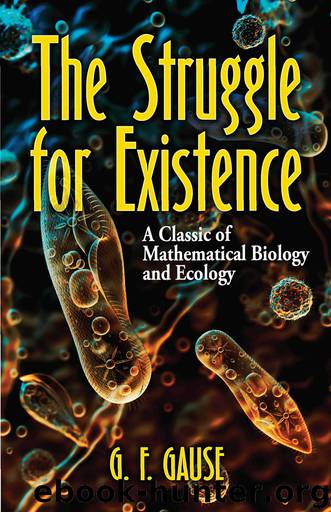The Struggle for Existence: A Classic of Mathematical Biology and Ecology by G. F. Gause

Author:G. F. Gause
Language: eng
Format: epub
Publisher: Courier Publishing
Published: 2019-03-13T16:00:00+00:00
FIG. 12. The effect of additional alcohol upon the level of saturating population in Saccharomyces cerevisiae in test tubes.
These data were criticized by Klem (’33) who carried out experiments with wort and not with William’s synthetic medium, which Richards worked upon. Klem did not obtain any depression of growth by adding a small quantity of alcohol corresponding to the quantity which is usually accumulated in his cultures at the moment when the growth ceases. According to Klem, it is only at a concentration above 3 per cent that alcohol begins to depress growth, and only concentrations of about 7 per cent have a distinctly hindering influence. The experiments which I have made with yeast decoction and 5 per cent sugar confirm the data of Richards and not those of Klem. Figure 12 presents the results of several experiments. The level of the maximal population in the control was taken as 100, and the levels of the maximal populations in the cultures with this or that per cent of alcohol (added before the yeast was sown, all other conditions being equal) were expressed in per cent from the population level in the control. This figure shows that even 1 per cent of alcohol in our conditions lowers the maximal level of population considerably. As we have already seen (Fig. 11, bottom) at the moment the growth ceases in our cultures the concentration of alcohol is near to 2 per cent (with the usual composition of medium). This concentration is undoubtedly sufficiently high to be responsible for the cessation of growth.
Klem expressed an interesting idea, namely that the cessation of growth is connected with the reaching of a definite relation between the concentration of the waste-products and the nutritive substances, i.e., alcohol and sugar. In other terms, the critical concentration of alcohol checking growth is by no means of an absolute character. With a small concentration of sugar, a comparatively weak concentration of alcohol hinders growth. But if the quantity of sugar be increased, this concentration of alcohol will no longer be sufficient for checking growth which will continue. Klem’s opinion is perfectly justified and many experimental data confirm it. But, as he himself remarks, the ratio alcohol/sugar left at the moment growth ceases, also varies within rather wide limits. (A critical analysis of Figs. 53–54 on pp. 80–81 of his paper (’33) shows that even with concentrations of sugar from 1 to 5 per cent the ratio alcohol/sugar left does not remain constant, and that Klem’s calculations are not quite exact.)
(4) All we have said may be resumed thus: under our conditions of cultivation the cessation of growth of the population of yeast cells begins before the exhaustion of the nutritive and energetic resources of the medium. The direct cause of this cessation is the accumulation of ethyl alcohol which kills the most sensitive members of the population—the young buds. This critical concentration of alcohol is not of an absolute character, and in a first approximation we can say that the
Download
This site does not store any files on its server. We only index and link to content provided by other sites. Please contact the content providers to delete copyright contents if any and email us, we'll remove relevant links or contents immediately.
| Anatomy | Animals |
| Bacteriology | Biochemistry |
| Bioelectricity | Bioinformatics |
| Biology | Biophysics |
| Biotechnology | Botany |
| Ecology | Genetics |
| Paleontology | Plants |
| Taxonomic Classification | Zoology |
Sapiens: A Brief History of Humankind by Yuval Noah Harari(14322)
The Tidewater Tales by John Barth(12627)
Mastermind: How to Think Like Sherlock Holmes by Maria Konnikova(7281)
Do No Harm Stories of Life, Death and Brain Surgery by Henry Marsh(6908)
The Thirst by Nesbo Jo(6882)
Why We Sleep: Unlocking the Power of Sleep and Dreams by Matthew Walker(6659)
Life 3.0: Being Human in the Age of Artificial Intelligence by Tegmark Max(5518)
Sapiens by Yuval Noah Harari(5325)
The Longevity Diet by Valter Longo(5043)
The Body: A Guide for Occupants by Bill Bryson(5032)
The Rules Do Not Apply by Ariel Levy(4912)
The Immortal Life of Henrietta Lacks by Rebecca Skloot(4552)
Animal Frequency by Melissa Alvarez(4430)
Why We Sleep by Matthew Walker(4395)
The Hacking of the American Mind by Robert H. Lustig(4342)
Yoga Anatomy by Kaminoff Leslie(4334)
All Creatures Great and Small by James Herriot(4273)
Double Down (Diary of a Wimpy Kid Book 11) by Jeff Kinney(4244)
Embedded Programming with Modern C++ Cookbook by Igor Viarheichyk(4143)
